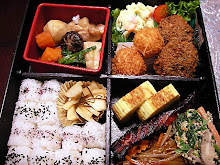

In the first morning in Shanghai, my sister, who's been living in Shanghai for 15 years, went out to get some humbaos from a street vendor nearby heated them up in a bamboo steamer and served them hot. It's a popular breakfast item in Shanghai it looks like. Both meat and veggie humbaos were tasty.
It's intriguing to compare different breakfast menus in different cultures. In the last 15 years of my life in Seattle, I have become addicted to crispy bacon strips on some weekend brunches but am still never a fan of sweet breakfast like pancakes and French toast. In Japan, a typical breakfast menu consists of plain rice & miso soup with something "salty" such as broiled salmon, fermented soybeans(natto), raw eggs with soysauce and/or vegetable pickles. How many Americans would be willing to smell like rotten soybeans when they get to work I wonder......


